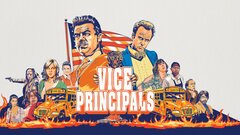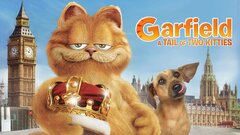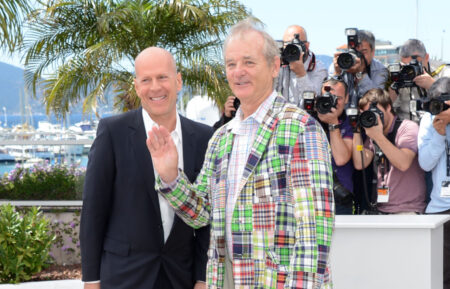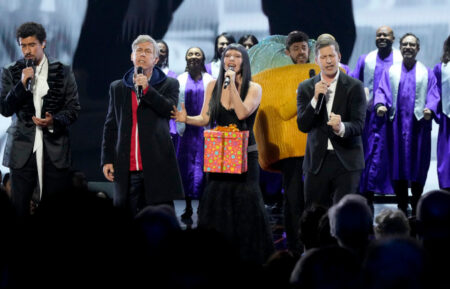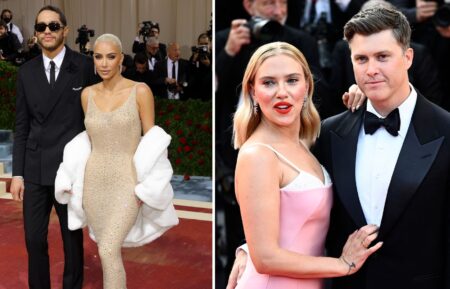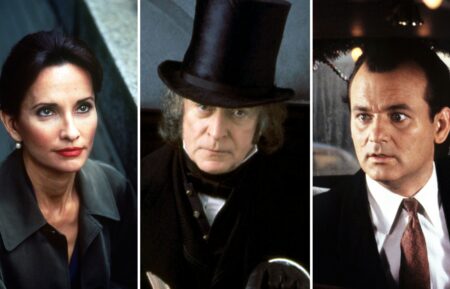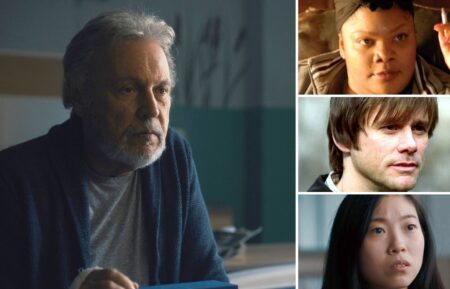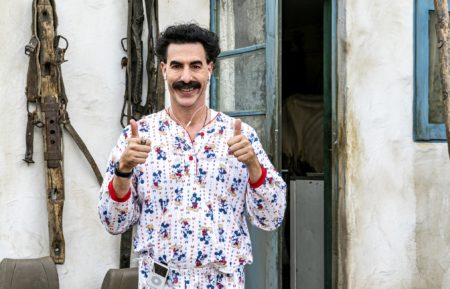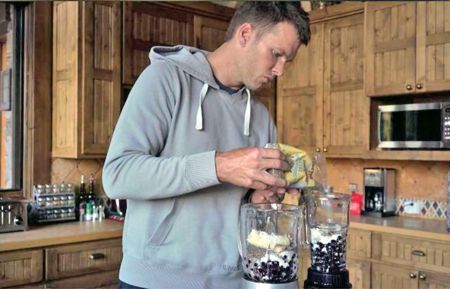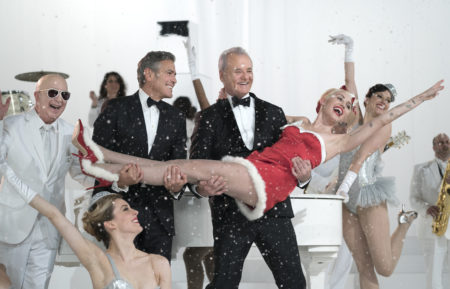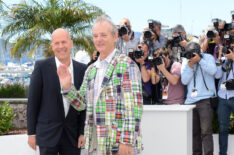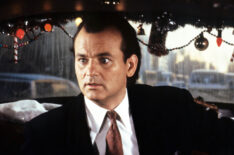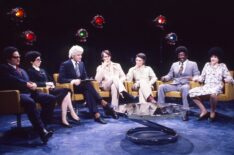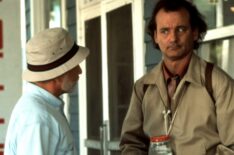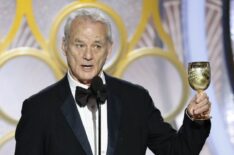A droll, iconoclastic comedic actor who enjoyed existing outside of Hollywood while thriving in it, Bill Murray carved a unique career that moved successfully from slapstick comedy to subtly complex seriocomic roles that earned him several awards and untold critical praise. After a stint in Chicago's famed comedy troupe, The Second City, Murray took over the space left behind by Chevy Chase on "Saturday Night Live" (NBC, 1975- ), where he made his bones as an unpredictable, but ultimately beloved performer. Murray used his success on "SNL" to make a string of successful slapstick comedies, starting with the sophomoric "Meatballs" (1979), which put him on the map, and the iconic "Caddyshack" (1980), which turned him into a certifiable movie star.
With his next film, "Stripes" (1982), Murray became synonymous with huge box office, which was confirmed by the gigantic success of his only bona fide blockbuster, "Ghostbusters" (1984). Though he attempted dramatic roles at the peak of his comedy streak - namely "The Razor's Edge" (1984) - Murray found difficulty breaking the confines of his comedic beginnings. It was only when he made gradual progressions - "Scrooged" (1988), "Groundhog Day" (1993), "Rushmore" (1998), and his Oscar-nominated performance in "Lost in Translation" (2003) - that Murray earned well-deserved respect for his deft ability to blend sharp comedy with emotionally complex characters.
Thanks to a trifecta of likability, durability and versatility, Murray cemented his stature as something of a national treasure in American pop culture over the course of a career that steadfastly refused to follow Hollywood convention.
Born Sept. 21, 1950 in Wilmette, IL, Murray was raised in a large Irish Catholic family, the fifth of nine children to his father, Edward, a lumber salesman, and his mother, Lucille, a mailroom clerk at a hospital supply company who supported the family on her own when Murray's father died in 1967. Though a smart kid, Murray was a poor student who worked, ironically, as a caddy at the Indian Hill Golf Club to pay his Catholic school tuition and began performing in school musicals so he could dance with girls.
After graduating Loyola Academy in 1968, Murray matriculated at Regis College, a school run by Jesuits where he had mild ambitions of becoming a doctor. But his sophomore year, Murray was kicked out after getting arrested for possession of marijuana at O'Hare International Airport in Chicago. Suddenly with few options at his disposal, Murray tried his hand at comedy when, in 1973, he joined Chicago's Second City - the famed long-running improvisational comedy troupe that started the careers of numerous comedy legends. His older brother, Brian Doyle-Murray, was already performing as a member of Second City, where the budding comedian eventually met the likes of Harold Ramis and John Belushi.
From his start at Second City, Murray's comedic gifts were evident to all. He riveted audiences with a constantly impending sense of danger; that anything could happen at any moment once he jumped on stage - not dissimilar to what Belushi possessed. It was at Second City that Murray performed prototypes for later "SNL" characters like Nick the Lounge Singer and his "Weekend Update" newscaster persona. He soon left the troupe to follow Ramis, Belushi and his brother first to New York to perform on "The National Lampoon Radio Hour," then later off-Broadway in "The National Lampoon Show."
Then in 1976, Murray joined the cast of "Saturday Night Live" to fill the void left behind by the departing Chevy Chase, who made a name for himself as the show's top performer that first season but later admitted he jumped too soon into Hollywood features. Making his first appearance in early 1977, Murray was initially hard pressed to win over Chase's fans. Despite a shaky start that included forgetting lines and looking awkward on camera, he quickly endeared audiences with a gallery of smarmy characters, including Nick the Lounge Singer, Shower Mike, and Todd DiLamuca, whose famous noogies became an instant classic.
When Chase returned to host in 1978, however, the two erupted backstage in a fight right before broadcast, with Chase perhaps feeling threatened that the scrappy upstart had officially made his mark. Murray, for his part, was never shy to throw a punch, leaving Belushi to pull them apart. The two comics would go on to become friendly in later years, but competition and pressure ignited a mini-feud between the future "Caddyshack" co-stars at that time.
With his position in America's living rooms every Saturday night secure, Murray was free to explore other mediums, namely movies, like his good buddy Belushi discovered when he hit a box office homerun with 1978's "National Lampoon's Animal House." Knowing it was now his time, Murray made his first breakthrough on the big screen with the teen-aimed screwball comedy, "Meatballs" (1979), playing the head counselor at a Camp Northstar, a low-rent summer camp ran by an amiable gang of misfits.
Murray continued to excel on "Saturday Night Live" through season five, but by then the original cast had been leaving for greener pastures, while the backstage problems - namely too many drugs and broken relationships (specifically between he and Gilda Radner) - nearly ended the series, which was sinking under its own excesses. After Belushi and Aykroyd left the show in early 1979, Murray left after one more season (5) to pursue features fulltime and landed perhaps his most notorious role in "Caddyshack" (1980), playing Carl, a seriously deranged, stoned-out greenskeeper at an exclusive country club.
While an obnoxious land developer (Rodney Dangerfield) shows up wanting to turn the grounds into condominiums, upsetting an uptight judge (Ted Knight) while befriending a millionaire slacker (Chevy Chase), Carl hunts down a cunning gopher with increasingly violent means. With the exception of "Animal House," "Caddyshack" set the standard for all low-brow comedies at that time - culminating in Murray famously biting into a pool-soaked chocolate bar which resembled something less appetizing. The film not only became a monster hit, it enhanced Murray's celebrity status and made him a bankable star.
Fresh from his four seasons at "SNL" and the success of his first two movies, Murray forged ahead into the 1980s to become one of Hollywood's most bankable - albeit iconoclastic - stars. In perhaps one of his least remembered early movies, "Where the Buffalo Roam" (1980), Murray deftly played Gonzo journalist Hunter S. Thompson, whose wild, drug-fueled antics written about in his numerous books and articles were brought to life for the big screen in hodgepodge fashion. Though Murray's performance was hailed by critics, the movie itself was savaged for its lack of coherence.
Murray redeemed himself next with one of his most inspired comedies, "Stripes" (1981), playing an unrepentant loser who impulsively joins the Army with his buddy (Harold Ramis) after losing his job, his car and his girlfriend all in one day. But when they arrive for basic training, they are lumped into a unit full of misfits led by a prickly drill sergeant (Warren Oates) disgusted with his new set of recruits. "Stripes" was a huge hit for Murray and director Ivan Reitman (their second collaboration), cementing itself in the pantheon of classic comedies, as well as introducing to mainstream audiences the comic genius of Canada's John Candy.
With two major comedy hits under his belt, it was only a matter of time until Murray entered blockbuster territory. Before he did, Murray had a memorable - and often scene-stealing - supporting role in "Tootsie" (1982), playing the struggling writer roommate of an unemployed actor (Dustin Hoffman) who dresses as an older woman in order to land a role on a popular soap opera. Murray insisted he be unbilled for his hilarious part in one of the best comedies of the 1980s. But it was his next feature, "Ghostbusters" (1984), that propelled him into a superstardom that eclipsed that of even his former "SNL" cohorts, save for the later seasons' standout, Eddie Murphy.
As one of four New York paranormal investigators fighting against a suddenly influx of demons terrorizing New York City, Murray was in top form, elevating his casual charm and droll delivery to a fine art, often adlibbing some of the more classic lines ("You're right Egon, no human would stack books that way ") Though sharing the spotlight with Harold Ramis and Dan Aykroyd - and to a lesser extent Ernie Hudson - Murray stole the show in a role that was originally written for Belushi, who died in 1982 of a drug overdose. In addition to grieving, Aykroyd and Ramis had to rewrite the script to suit Murray's less manic comic sensibilities, putting a long desired project on hold. But the delay was worth its weight in gold - "Ghostbusters" became more than a hit; it was a cultural phenomenon, earning a huge take at the box office while spawning a top-selling single, complete with an overplayed music video; two sequels; an animated series; countless toys and costumes; and years later, a video game. It may also have been - along with "Caddyshack" - one of the most quoted comedies in the history of film, with every moviegoer having his or her particular favorite.
After "Ghostbusters" and his other successes, Murray suddenly found himself on top of Hollywood - the perfect time to make a pet project destined to be a disaster. Reportedly, Murray only signed on to "Ghostbusters" if Columbia TriStar financed his passion project, "The Razor's Edge" (1984), a remake of the 1946 Tyrone Power film based on the novel by W. Somerset Maugham. No film prior was more important to Murray than "The Razor's Edge," a script he co-wrote that included an almost angry monologue he added as a dedication to his fallen friend, Belushi. But audiences, who were unaccustomed to seeing Murray in a dramatic role, stayed away from WWI-set "The Razor's Edge" in droves, causing the film - in which Murray gave a strong performance - to flop at the box office. Because of the failure, and despite the success of "Ghostbusters," Murray quit acting and moved to Paris, where he studied philosophy and history at the Sorbonne. Though offers still came his way, Murray was able to attend classes and spend time with his family in peace. He did make a hilarious cameo as a masochistic dental patient in "Little Shop of Horrors" (1986), but for the most part he stayed completely away from film for a good four years.
In 1988, Murray emerged from his self-imposed exile to star in a tailor-made vehicle, "Scrooged" (1988), a surreal comedy based on Charles Dickens' A Christmas Carol. Murray played Frank Cross, a narcissistic television executive who gets visited by the ghosts from Christmas Past, Present and Future, forcing him to come to terms with and overcome his life-long nastiness to others. For the first time, Murray effectively conveyed to a large audience his ability to remain a strong comedy presence while exuding undertones of seriousness by playing a heartless character who in the end finds his heart. The following year, he went back to the well with "Ghostbusters II" (1989), an ill-advised, but still immensely profitable sequel that failed on all fronts to live up to the crackling freshness of the original. After playing a bank robber clown in the little-seen caper comedy "Quick Change" (1990), Murray was in top form in as a neurotic mental patient who latches onto his psychiatrist (Richard Dreyfuss) and his family, driving the good doctor plum mad in "What About Bob?" (1991).
Murray followed with the underappreciated dark comedy "Mad Dog and Glory" (1993), playing a Chicago mob boss so thankful for a cop (Robert De Niro) saving a gangster's life, that he gives him a female bartender (Uma Thurman) as a gift. In this film, audiences were actually frightened of Murray, who really poured on the ugly intensity in scenes opposite De Niro, of all people.
By the 1990s, Murray had effectively left his goofball comedy days behind to focus more on comedies that featured more emotionally complex characters more droll than outright funny. He raised his game with a sterling performance in "Groundhog Day" (1993), playing a bitter and self-centered television weatherman forced to repeat the same day in Punxsutawney, PA over and over and over again until he finally learns how to live life and be nice to people. Though not a major success by past standards, "Groundhog Day" nonetheless allowed Murray to pull out all the comedic stops while endearing himself to audiences as a viable romantic lead opposite Andie MacDowell. The film, actually more successful after its home video release and a bit of a cult favorite. After a strong supporting role as wealthy socialite Bunny Breckinridge in Tim Burton's excellent "Ed Wood" (1994), Murray stole the show in another co-starring performance, playing a former bowling hustler-turned-champion 20 years after he ended the career - and right hand - of a promising protégé (Woody Harrelson) in the Farrelly Brothers' underrated comedy, "Kingpin" (1996), in which Murray sported perhaps the worst combover hairstyle in film history.
Back to starring roles, Murray fell on his face with the lame "Larger Than Life" (1996) and "The Man Who Knew Too Little" (1998), both of which diminished his leading status temporarily.
It was clear by the time the 1990s were drawing to a close that Murray was better suited in subversive supporting roles, made clear by his failures in mid-decade. In what became a harbinger of things to come, Murray gave his finest droll performance in "Rushmore" (1998), playing a self-made millionaire Herman Blume who befriends an eccentric student, Max Fisher (Jason Schwartzman), at a prestigious private school. Written with the actor in mind by Wes Anderson, Murray's Blume exudes misery, thanks to an indifferent wife and two spoiled sons who also attend Rushmore. Life suddenly brightens, however, when he takes the 15-year-old Max Fischer under his wing, bonding over a mutually-shared background and Max's undeniable, albeit, misplaced enthusiasm. But when he realizes that Blume is attracted to a teacher (Olivia Willams) who is the object of his affections, Max declares war and the two engage in mean-spirited tit-for-tat with ugly repercussions. While there were laughs-a-plenty in "Rushmore," Murray delivered a layered performance, reveling in Blume's mercilessness while still managing to convey more serious and conflicted feelings. Critics proclaimed "Rushmore" the best work of his career, stoking hype for an Oscar nod that never came. He did win Critics Circle Awards in New York and Los Angeles, establishing himself as a serious actor worthy of greater consideration.
Murray's brief, but affective and moving turn as ventriloquist Tommy Crickshaw in director Tim Robbin's 1930s WPA story "The Cradle Will Rock" (1999) was another step in developing his more seriocomic side, while his amusing, light-as-a-feather sidekick stint as a post-modern Bosley in the hyperactive big screen version of "Charlie's Angels" (2000) seemed a complete lark and a role that he seemed to phone in. Though a fair success, Murray was not to return for the "Charlie's Angels" sequel, thanks to an on-set feud between him and co-star Lucy Liu that shut down production for an entire day. In perhaps his first stab at Shakespeare, he gave a stand-out performance as Polonius in a modern update of "Hamlet" (2000), starring Ethan Hawke as the troubled heir of Denmark Corp. Less well-received was "Osmosis Jones" (2001), an unorthodox hybrid of live action and animation directed by the Farrelly Brothers which featured cartoon antibodies and germs battling for supremacy inside the body of the hapless and sickly Frank (Murray).
That same year, Murray successfully reunited with Wes Anderson as part of the large comedic ensemble of the writer-director's highly praised dark comedy "The Royal Tenenbaums" (2001), in which he had a small role as the mild-mannered and romantically unlucky analyst Raleigh St. Clair.
Murray's transition to full-fledged dramatic actor came to sublime fruition in "Lost in Translation" (2003), writer-director Sophia Coppola's wonderfully romantic film about an emotionally adrift 50-something Hollywood actor, Bob Harris, who is in Tokyo to film a whiskey commercial and forms a deep, complex and ultimately platonic relationship with a young married tourist, Charlotte (Scarlett Johansson). Coppola conceived the role and its blend of comedy and tragedy specifically for Murray, going as far as to say she would not make the movie without him. Coppola spent considerable time wooing the actor, pursuing him via their mutual friend, screenwriter Mitch Glazer, for months before finally winning him over, as Murray had no representation. The results of her quest were well worth it: Murray was never more charming and vulnerable playing Bob Harris, who discovers a kindred spirit in Charlotte, even as he struggles with a floundering marriage. Murray demonstrated a razor-sharp comedic timing, while displaying a rare, multilayered chemistry with Johansson, despite their age difference. Their rapport, which was at first tentative, then confident and cozy, then finally awkward and sexual, fueled the film and carried many scenes without dialogue. The tour de force performance earned Murray a sea of critical kudos and numerous award nominations, including a nod for Best Actor at the Academy Awards, a BAFTA Award for Best Actor and a Golden Globe victory for Best Actor in a Musical or Comedy. When he lost the Oscar, many felt Bill Murray had been seriously robbed.
Ironically, Murray's next stint on the big screen was a very disparate project, providing the sardonic voice of the comic strip cat in the otherwise lackluster big screen adaptation of "Garfield" (2004). After an appearance in the reflective "Coffee and Cigarettes" (2004), Murray reunited with director Wes Anderson for "The Life Aquatic with Steve Zissou" (2004).
Quirky in the extreme, but with several instances of comedic brilliance and genuinely moving moments, "The Life Aquatic" cast Murray as a Jacques Cousteau-like oceanographer and filmmaker whose sagging fortunes and sense of ennui are revitalized when he adds his possible son (Owen Wilson) to his crew. Though the film was flawed, playing Zissou allowed Murray to again demonstrate his flair from combining the dramatic with the comedic.
Next was another acting triumph in writer-director Jim Jarmusch's seriocomic "Broken Flowers" (2005), in which Murray was a resolute bachelor who receives an anonymous letter from a former lover revealing that he has a 19-year-old son, prompting him to embark on a cross-country journey to visit a series of his old flames and get to the heart of the mystery.
Following the sequel "Garfield: A Tail of Two Kitties" (2006) and a smaller role as an unnamed businessman in Anderson's disappointing comedy "The Darjeeling Limited" (2007), Murray took a backseat to Steve Carell in the long-desired big screen treatment of "Get Smart" (2008).In the post-apocalyptic adventure fable "City of Ember" (2008), Murray played the unscrupulous mayor of an underground community slowly running out of energy, resources and time.
The following year, he turned in a hilarious cameo as himself in the horror comedy "Zombieland" (2009), starring Jesse Eisenberg and Woody Harrelson as survivors in a world overrun by the living dead. Murray reteamed with indie director Jim Jarmusch for a small supporting role as an unnamed American corporate executive in the enigmatic crime drama "The Limits of Control" (2009). Sticking with familiar directors for the time being, he also lent his voice to Wes Anderson's whimsical stop-motion animated feature, "The Fantastic Mr. Fox" (2009), as the wily title character's (George Clooney) friend and attorney, Badger.
Based on the beloved children's book by Roald Dahl, the wonderfully inventive film boasted an impressive cast of voice talent, including Meryl Streep, Owen Wilson and Jason Schwartzman. Back in front of the camera, he delivered another uniquely Murray-esque performance in the period mystery drama, "Get Low" (2010), as a cash-strapped mortician eager to assist a curmudgeonly hermit (Robert Duvall) with his plans to throw a "funeral party" for himself before he dies. Murray's humorous, yet modulated portrayal garnered him an Indie Spirit Award nod for Best Supporting Male.
After a reunion with Anderson for "Moonrise Kingdom" (2012), Murray expanded his dramatic horizons with a starring performance as President Franklin D. Roosevelt in "Hyde Park on Hudson" (2012), a winning drama about the forging of the relationship between FDR and England's King George VI (Samuel West). His performance of the 32nd president earned Murray a Golden Globe nod for Best Actor in a Comedy or Musical.
Small roles in Roman Coppola's "A Glimpse Inside the Mind of Charles Swan III" (2012) and Wes Anderson's "The Grand Budapest Hotel" (2014) followed, along with a larger supporting role in George Clooney's World War II comedy-drama "The Monument Men" (2014) and the acclaimed mini-series "Olive Kitteridge" (HBO 2014). Murray also appeared occasionally as a U.S. Senator on the Garry Trudeau-penned comedy "Alpha House" (Amazon 2013-14) and had a cameo in the long-anticipated comedy sequel "Dumb and Dumber To" (2014).
The same year, he starred opposite Melissa McCarthy in the comedy-drama "St. Vincent" (2014), playing a crotchety neighbor antagonizing the single mom and adolescent boy who move in next door. After a small supporting role in Cameron Crowe's "Aloha" (2015), Murray starred in Barry Levinson's "Rock the Kasbah" as a rock manager having a personal crisis in war-torn Afghanistan.





























